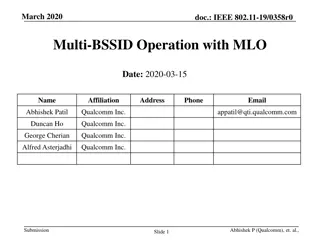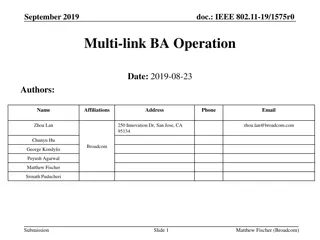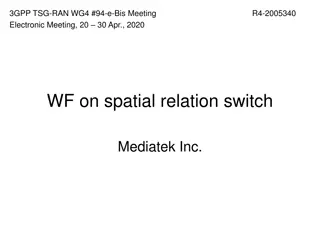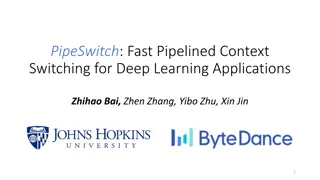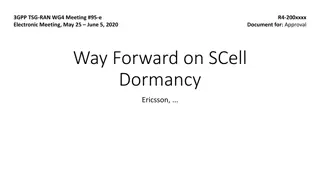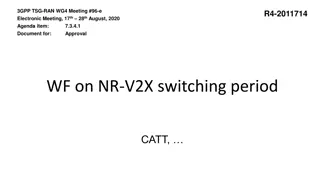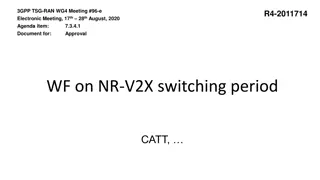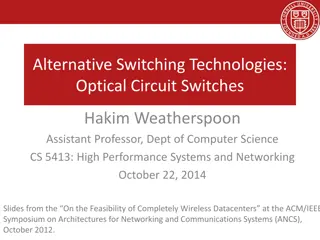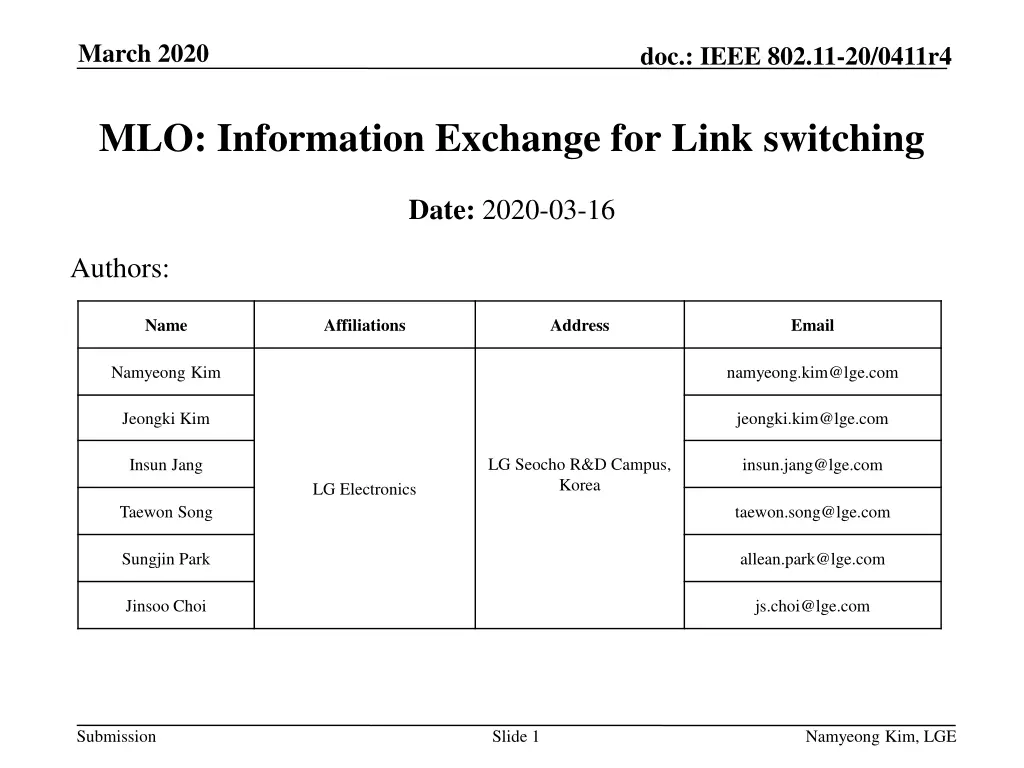
Information Exchange for Link Switching in IEEE 802.11-20
Explore the methods proposed for obtaining additional information in IEEE 802.11-20 for efficient link switching, addressing constraints on information acquisition and enhancing multi-link setup signaling exchanges. Discover how STAs can request specific information from APs and how APs can provide information without solicitation to optimize link performance.
Download Presentation

Please find below an Image/Link to download the presentation.
The content on the website is provided AS IS for your information and personal use only. It may not be sold, licensed, or shared on other websites without obtaining consent from the author. If you encounter any issues during the download, it is possible that the publisher has removed the file from their server.
You are allowed to download the files provided on this website for personal or commercial use, subject to the condition that they are used lawfully. All files are the property of their respective owners.
The content on the website is provided AS IS for your information and personal use only. It may not be sold, licensed, or shared on other websites without obtaining consent from the author.
E N D
Presentation Transcript
March 2020 doc.: IEEE 802.11-20/0411r4 MLO: Information Exchange for Link switching Date: 2020-03-16 Authors: Name Affiliations Address Email Namyeong Kim namyeong.kim@lge.com Jeongki Kim jeongki.kim@lge.com LG Seocho R&D Campus, Korea Insun Jang insun.jang@lge.com LG Electronics Taewon Song taewon.song@lge.com Sungjin Park allean.park@lge.com Jinsoo Choi js.choi@lge.com Submission Slide 1 Namyeong Kim, LGE
March 2020 doc.: IEEE 802.11-20/0411r4 Overview We agreed that 802.11be defines a multi-link setup signaling exchange executed over one link initiated by a non-AP MLD with an AP MLD as follows [1]: Capability for one or more links can be exchanged during the multi-link setup. After multi-link setup, a STA may request an AP to switch the operating link to improve the performance. For example, there are the cases where the STA is to avoid channel congestion or interference, and so on. In this contribution, we does not focus on link switching process (e.g. the detail of link switching operation may be replaced with TID-to-link mapping procedure). To select a suitable switching link, the STA should know current information of other APs. For this, the STA needs the method to obtain up-to-date information. Submission Slide 2 Namyeong Kim, LGE
March 2020 doc.: IEEE 802.11-20/0411r4 The constraints on obtaining information A STA can periodically acquire the information of other APs from Beacon frame, but there may be some constraints on link switching in the following cases. Case 1: the lack of information Beacon frame can provide partial information of other APs to avoid bloating, which may not provide information needed for link switching. Case 2: the out-of-date information A STA can have too long listen interval to get the latest information about link. Note that the STA which supports constrained battery may have long beacon interval. The previously obtained link information from the beacon frame may be different from the current link information In this contribution, we propose the method for a STA to obtain additional information (e.g., other AP s capability, BSS parameters, etc.) after multi-link setup. Submission Slide 3 Namyeong Kim, LGE
March 2020 doc.: IEEE 802.11-20/0411r4 Proposal 1: The solicited method to obtain additional information A STA of non-AP MLD can request an AP of AP MLD the specific information of one or more APs of AP MLD after multi-link setup. On receiving the request frame, the AP sends a response frame including the information required by the STA. For example, when STA 2 requests the BSS load of all APs affiliated with AP MLD, the AP 2 sends a response frame including BSS load of AP 1, 2, 3 to STA 2. Submission Slide 4 Namyeong Kim, LGE
March 2020 doc.: IEEE 802.11-20/0411r4 Proposal 2: The unsolicited method to obtain additional information An AP can provide information of other APs affiliated with AP MLD to a STA without requesting by the STA. An AP of AP MLD can send a STA of non-AP MLD a frame to provide information (e.g. updated other AP s capabilities, operation element, BSS parameters) after multi-link setup. The signaling for notifying specific information is TBD (e.g., FILS Discovery frame, Broadcast Probe response, etc.). The AP may send this information periodically (e.g., 20 us). For example, an AP 2 announces a message to STA 2 to provide changed STR capability information of AP MLD. Submission Namyeong Kim, LGE
March 2020 doc.: IEEE 802.11-20/0411r4 Conclusion Considering the cases where a STA of non-AP MLD does not have enough information to determine the suitable switching link, we propose the method for the STA to obtain additional information. A STA of non-AP MLD can request specific information of one or more APs not acquired through a beacon to associated AP MLD. For example, the information can be BSS load of other APs of the associated AP MLD. Also, an AP of AP MLD can provide the updated information of APs affiliated with AP MLD to STA which is associated with the AP MLD without request from STA. For example, the information can be STR capability of the associated AP MLD. Submission Slide 6 Namyeong Kim, LGE
March 2020 doc.: IEEE 802.11-20/0411r4 Reference [1]: 11-19-1262-08-00be-specification-framework-for-tgbe [2]: 11-19-1526 Multi-link power save Submission Slide 7 Namyeong Kim, LGE
March 2020 doc.: IEEE 802.11-20/0411r4 Recap: Proposal A STA of a non-AP MLD can request a peer AP of AP MLD a part of complete information of other APs of the same AP MLD. Using this method, the STA can request only a part of information for other APs currently required. The STA can request any information of other APs (e.g. information which is not included on beacon frame sent from the peer AP) without monitoring other links. The STA can request specific information of other APs (e.g. only updated BSS parameters) before switching/waking up to avoid service disruption. This can be one of the solutions for beacon bloating issue and it will be able to reduce frame overhead by requesting only required information and save more power. Submission Slide 8 Namyeong Kim, LGE
March 2020 doc.: IEEE 802.11-20/0411r4 SP #1 Do you agree to define the following mechanism: A STA of a non-AP MLD can request a peer AP of AP MLD a part of complete information of other APs of the same AP MLD. The signaling for requesting the part of complete information is TBD. NOTE: As an example, the part of complete information may be information that is not included on the beacon frame sent from the peer AP. Submission Slide 9 Namyeong Kim, LGE

